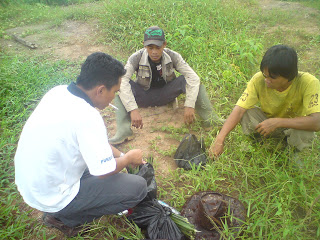1. Two-stage nurseries
- Follow the fertilization schedule listed in Table 1
- Prepare the provision of fertilizer solution at the first stage, dissolve 8, 16 and 24g NPK 15/15/6/4 into 5 liters of water for 100 seedlings.
- Application should be made using hype.
- Seedlings should be watered 1 hour after application of fertilizer so that the leaves do not 'burn out'.
- Seeds moved to large polybags at 13 weeks.
- If the transfer is delayed, continue weekly fertilization using a dose of 12 weeks.
- Follow the fertilization schedule listed in Table 2.
- Prepare the provision of fertilizer solution in the first month, dissolve 8g NPK 15/15/6/4 into 5 liters of water for 100 seedlings.
- Application should be made using hype.
- Watering should be done immediately after the application of fertilizer so that the leaves do not burn.
- If the seed is not planted to the field after the age of one year (eg to insert / APM), continue fertilizing with NPK 12/12/17/2 35g doses per month and 20 grams Kieserite every two months.
- No application of fertilizer during the first 4 months.
- After that, follow the fertilizing schedule is shown in Table 3.
- If the 1-year-old seedlings have not been transferred to the field, continue fertilizing with NPK 12/12/17/2 40g dose every two months.
- Symptoms of deficiency are very common are: N - all pale colored leaves Mg - lower leaves yellow B - young leaves crimp / shrink
- If the visible symptoms of deficiency, do the following:
- N In the early stages (eg 1-3 leaves) spray with a solution of (7g urea + 5 liters of water) for 100 seedlings. For older seeds that seed, spray with a solution (14g urea + 5 liters of water) for 100 seedlings.
- Mg For young seedlings seeds (less than 3 months) spray with a solution (20g salt English + 5 liters of water) for 100 seedlings. For older seeds that seed, tambahankan Kieserite a dose of 10 grams (age 3-6 months) or 20 grams (6-12 months) per subject.
- B Spray with a solution (10g HGFB + 5 liters of water) for 100 seedlings.
- Fe Spray with a solution (10g EDTA or if not available, use iron sulphate + 5 liters of water) for 100 seedlings.


